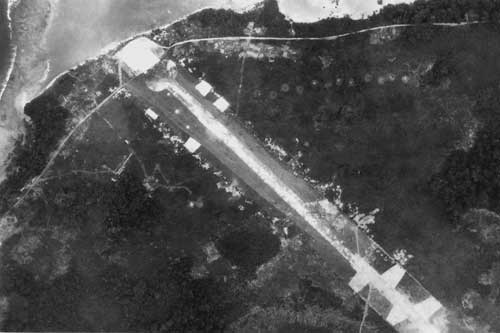By April 1942, the 3rd Bomb Group was about two weeks into training on the B-25. This training was suddenly put to the test when an order came through for any operational 3rd Bomb Group B-25s to fly to Port Moresby for a raid on the Japanese airfield at Gasmata on April 6th. These planes and crews came from the 13th Squadron, since they already had their new bombers. Six B-25s took off from Charters Towers, Australia on April 5th for a night’s stay in Port Moresby, prepared to hit Gasmata on the 6th. The 13th Squadron C.O., Capt. Herman Lowery, would lead the strike.
The next day, five of the B-25s took off (the sixth was unable to) without a fighter escort due to the distance to the target. This was the official combat debut of the B-25. The 350-mile flight from Port Moresby to Gasmata was pushing the operational range of the B-25. Any delay over or near the target area would mean the crew(s) would not be able to make it back to Port Moresby without running out of fuel. The planes made their runs on Gasmata between 4500 and 5000 feet, and the three crews that decided to hit the southeast portion of the runway came in under heavy antiaircraft fire. Some of the planes suffered minor damage, but none of the crews were injured. All returned to Port Moresby and later to Charters Towers without incident.
Not long after this mission, rumors about a bigger raid started floating around camp. General Jonathan Wainwright wanted to see the Allies take out the Japanese blockade around Manila Harbor so troops on Bataan could receive badly needed supplies. General Brett was reluctant to put MacArthur’s idea into action, as he felt that the limited resources of the Allies would be better used to build up air power in Australia. Brigadier General Ralph Royce was more enthusiastic about the prospect, and decided to write up a mission estimate for a possible raid on “Miami,” the code name for the Philippines. He quietly urged Gen. Brett to supervise the raid, pointing out that it would enhance Brett’s position with MacArthur. When Brett declined, Royce said that since no one else had the experience for this sort of mission, he would oversee it. Brett agreed to let him lead the raids.
The mission was offered to to the 3rd Bomb Group and accepted by Col. John Davies. With that, the Group’s B-25s were sent to Archerfield at Brisbane, Australia where they were outfitted with 1200-gallon tanks in the bomb bays in order to safely make such a long flight. Originally, there were plans to add smaller fuel tanks to the bombardier’s compartment in the nose as well, but those were scratched. Just as they had done when they ferried planes from Hawaii to Australia, the crews would rely on the auxiliary bomb bay fuel tanks. Afterwards, they flew back to Charters Towers, where the planes were loaded with food, medicine, and other long-awaited supplies for then men on Bataan.
On April 8th, MacArthur wired Gen. Wainwright about his desperately-needed support finally being on its way. Unfortunately, that day also marked the surrender of Bataan to the Japanese. Even with the shock the news generated, the men were more determined than ever to do what they could to help out their friends and colleagues. “We’re all sick over Bataan,” wrote 1/Lt. Jim McAfee in his diary.
Continue to part 2, The Royce Raid: Journey to Del Monte


Reblogged this on pacificparatrooper and commented:
The Pacific War raged on as the men endured the Bataan Death March.
LikeLiked by 3 people
Thanks again for the reblog!
LikeLiked by 1 person
Thanks a lot for reblogging this interesting article. There is a lot of respect for the B-25, one of the aircraft used by virtually every Allied air force, including the Soviets, I believe.
LikeLike
Thank you for dropping by! 🙂 Did you get a chance to read the other parts of this series?
LikeLike
One more fear added to all the rest: the danger of running out of fuel before you could make it back. I wonder if any body has made a study of how fuel needs impacted the war? –Curt
LikeLike
That’s a great question. This thread might be relevant: http://www.ww2f.com/topic/14674-the-quest-for-fuel-in-world-war-ii/
And running out of fuel, especially over Japanese territory, was definitely a fear they had. The weather on April 16, 1944 caused a lot of trouble in that area: https://airwarworldwar2.wordpress.com/tag/black-sunday/
LikeLike
Pingback: International Historical Research Associates | The Royce Raid
Pingback: International Historical Research Associates | Prelude to the Royce Raid: Bombing Gasmata Airdrome
Pingback: Oral History: Doolittle Raiders | IHRA
Pingback: Repost: The 3rd Bomb Group’s Combat Debut: Prelude to the Royce Raid | IHRA
Pingback: Harvest of the Grim Reapers, Vol. I is at the printer | IHRA